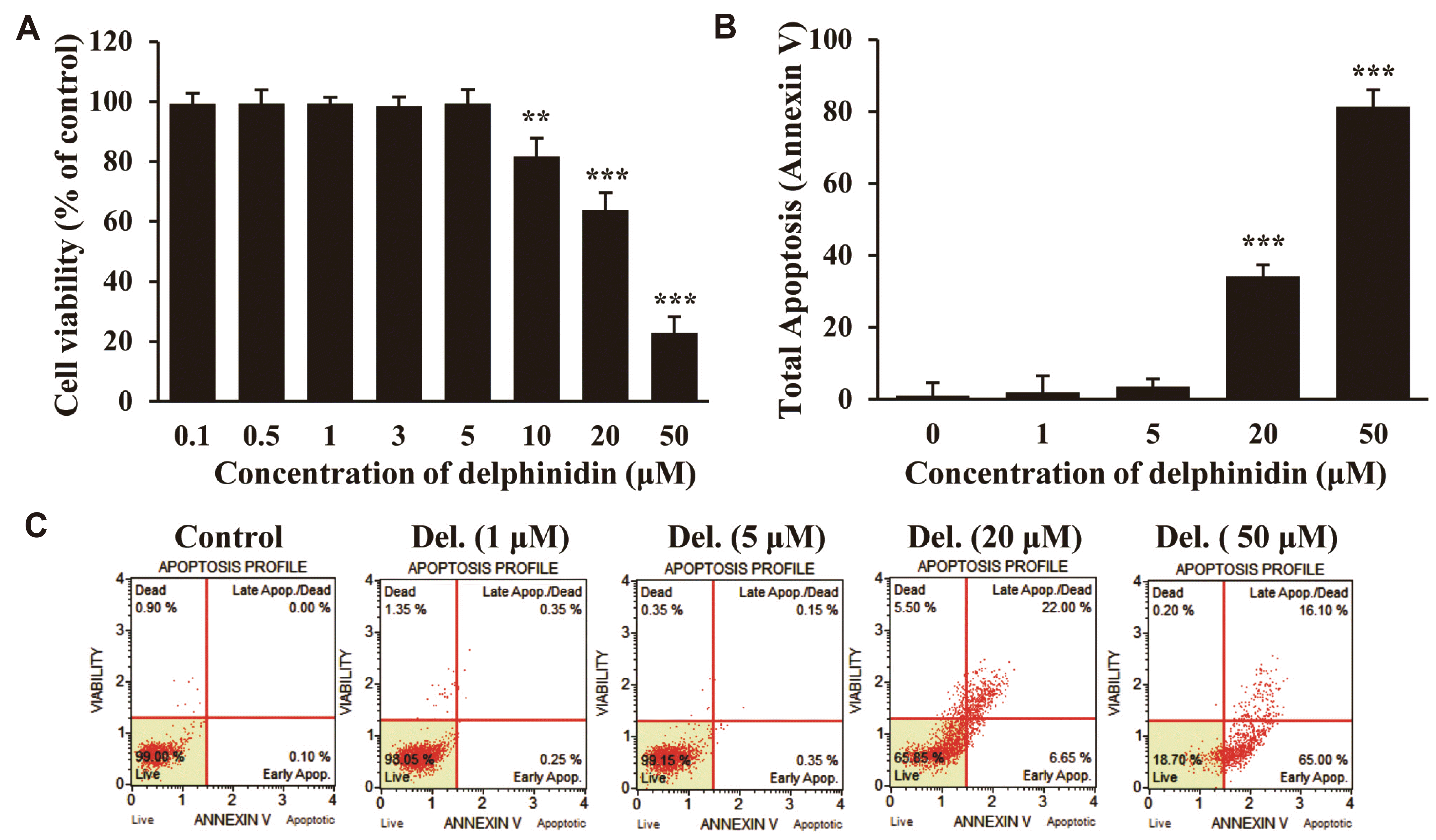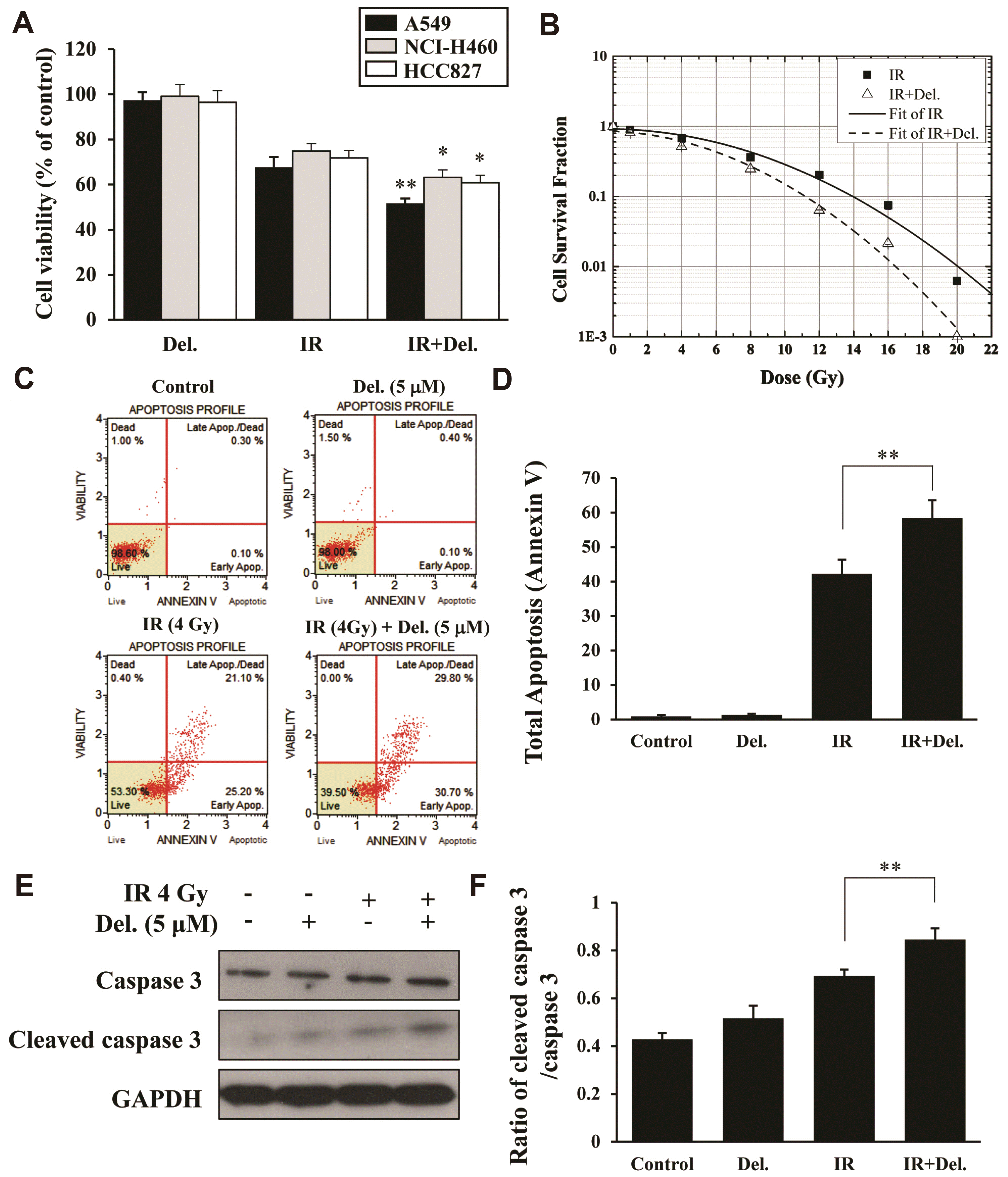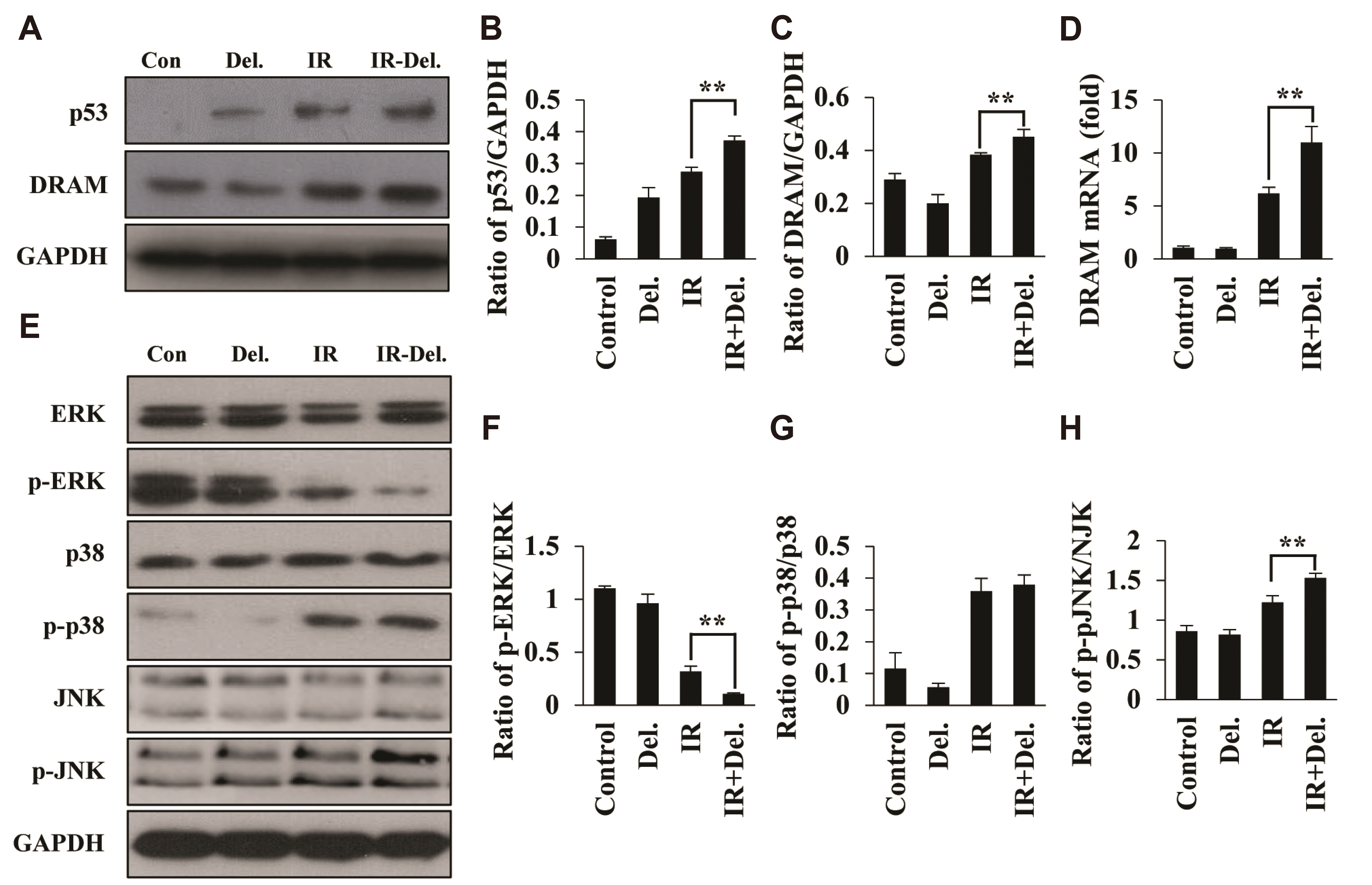1. Tsuyuki S, Fukui S, Watanabe A, Akune S, Tanabe M, Yoshida K. 2012; Delphinidin induces autolysosome as well as autophagosome formation and delphinidin-induced autophagy exerts a cell protective role. J Biochem Mol Toxicol. 26:445–453. DOI:
10.1002/jbt.21443. PMID:
23129091.

2. Wang H, Nair MG, Strasburg GM, Chang YC, Booren AM, Gray JI, DeWitt DL. 1999; Antioxidant and antiinflammatory activities of anthocyanins and their aglycon, cyanidin, from tart cherries. J Nat Prod. 62:294–296. DOI:
10.1021/np980501m. PMID:
10075763.

3. Kim B, Lee SG, Park YK, Ku CS, Pham TX, Wegner CJ, Yang Y, Koo SI, Chun OK, Lee JY. 2016; Blueberry, blackberry, and blackcurrant differentially affect plasma lipids and pro-inflammatory markers in diet-induced obesity mice. Nutr Res Pract. 10:494–500. DOI:
10.4162/nrp.2016.10.5.494. PMID:
27698956. PMCID:
PMC5037066.

4. Kasten-Pisula U, Windhorst S, Dahm-Daphi J, Mayr G, Dikomey E. 2007; Radiosensitization of tumour cell lines by the polyphenol Gossypol results from depressed double-strand break repair and not from enhanced apoptosis. Radiother Oncol. 83:296–303. DOI:
10.1016/j.radonc.2007.04.024. PMID:
17521756.

5. Bump EA, Hoffman SJ, Foye WO. Abraham DJ, editor. 2003. Radiosensitizers and radioprotective agents. Burger's medicinal chemistry and drug discovery. 6th ed. Wiley;Hoboken (NJ): p. 151–214. DOI:
10.1002/0471266949.bmc077.

6. Nambiar D, Rajamani P, Singh RP. 2011; Effects of phytochemicals on ionization radiation-mediated carcinogenesis and cancer therapy. Mutat Res. 728:139–157. DOI:
10.1016/j.mrrev.2011.07.005. PMID:
22030216.

7. Kim MH, Jeong YJ, Cho HJ, Hoe HS, Park KK, Park YY, Choi YH, Kim CH, Chang HW, Park YJ, Chung IK, Chang YC. 2017; Delphinidin inhibits angiogenesis through the suppression of HIF-1α and VEGF expression in A549 lung cancer cells. Oncol Rep. 37:777–784. DOI:
10.3892/or.2016.5296. PMID:
27959445.

8. Jeong MH, Ko H, Jeon H, Sung GJ, Park SY, Jun WJ, Lee YH, Lee J, Lee SW, Yoon HG, Choi KC. 2016; Delphinidin induces apoptosis via cleaved HDAC3-mediated p53 acetylation and oligomerization in prostate cancer cells. Oncotarget. 7:56767–56780. DOI:
10.18632/oncotarget.10790. PMID:
27462923. PMCID:
PMC5302952.

9. Chen J, Zhou J, Li F, Zhu Y, Zhang W, Yu X. 2017; [Delphinidin induces autophagy in HER-2+ breast cancer cells via inhibition of AKT/mTOR pathway]. Zhong Nan Da Xue Xue Bao Yi Xue Ban. 42:264–270. Chinese. DOI:
10.11817/j.issn.1672-7347.2017.03.005. PMID:
28364098.
13. Bialik S, Dasari SK, Kimchi A. 2018; Autophagy-dependent cell death - where, how and why a cell eats itself to death. J Cell Sci. 131:jcs215152. DOI:
10.1242/jcs.215152. PMID:
30237248.

14. Gozuacik D, Kimchi A. 2004; Autophagy as a cell death and tumor suppressor mechanism. Oncogene. 23:2891–2906. DOI:
10.1038/sj.onc.1207521. PMID:
15077152.

15. Kim TH, Kim HS, Kang YJ, Yoon S, Lee J, Choi WS, Jung JH, Kim HS. 2015; Psammaplin A induces Sirtuin 1-dependent autophagic cell death in doxorubicin-resistant MCF-7/adr human breast cancer cells and xenografts. Biochim Biophys Acta. 1850:401–410. DOI:
10.1016/j.bbagen.2014.11.007. PMID:
25445714.

16. Mohammadpour R, Safarian S, Ejeian F, Sheikholya-Lavasani Z, Abdolmohammadi MH, Sheinabi N. 2014; Acetazolamide triggers death inducing autophagy in T-47D breast cancer cells. Cell Biol Int. 38:228–238. DOI:
10.1002/cbin.10197. PMID:
24155029.
17. Kulkarni YM, Kaushik V, Azad N, Wright C, Rojanasakul Y, O'Doherty G, Iyer AK. 2016; Autophagy-induced apoptosis in lung cancer cells by a novel digitoxin analog. J Cell Physiol. 231:817–828. DOI:
10.1002/jcp.25129. PMID:
26264876. PMCID:
PMC4751068.

18. Degenhardt K, Mathew R, Beaudoin B, Bray K, Anderson D, Chen G, Mukherjee C, Shi Y, Gélinas C, Fan Y, Nelson DA, Jin S, White E. 2006; Autophagy promotes tumor cell survival and restricts necrosis, inflammation, and tumorigenesis. Cancer Cell. 10:51–64. DOI:
10.1016/j.ccr.2006.06.001. PMID:
16843265. PMCID:
PMC2857533.

20. Feng R, Wang SY, Shi YH, Fan J, Yin XM. 2010; Delphinidin induces necrosis in hepatocellular carcinoma cells in the presence of 3-methyladenine, an autophagy inhibitor. J Agric Food Chem. 58:3957–3964. DOI:
10.1021/jf9025458. PMID:
20025272.

21. Lee DY, Park YJ, Hwang SC, Kim KD, Moon DK, Kim DH. 2018; Cytotoxic effects of delphinidin in human osteosarcoma cells. Acta Orthop Traumatol Turc. 52:58–64. DOI:
10.1016/j.aott.2017.11.011. PMID:
29290536. PMCID:
PMC6136320.

22. Chen J, Zhu Y, Zhang W, Peng X, Zhou J, Li F, Han B, Liu X, Ou Y, Yu X. 2018; Delphinidin induced protective autophagy
via mTOR pathway suppression and AMPK pathway activation in HER-2 positive breast cancer cells. BMC Cancer. 18:342. DOI:
10.1186/s12885-018-4231-y. PMID:
29587684. PMCID:
PMC5870693.

23. Tanida I, Minematsu-Ikeguchi N, Ueno T, Kominami E. 2005; Lysosomal turnover, but not a cellular level, of endogenous LC3 is a marker for autophagy. Autophagy. 1:84–91. DOI:
10.4161/auto.1.2.1697. PMID:
16874052.

24. Otomo C, Metlagel Z, Takaesu G, Otomo T. 2013; Structure of the human ATG12~ATG5 conjugate required for LC3 lipidation in autophagy. Nat Struct Mol Biol. 20:59–66. DOI:
10.1038/nsmb.2431. PMID:
23202584. PMCID:
PMC3540207.

25. Mizushima N. Deretic V, editor. 2006. Transgenic models of autophagy. Autophagy in immunity and infection: a novel immune effector. Wiley-VCH;Weinheim: p. 55–67. DOI:
10.1002/352760880X.ch3.

26. Hafeez BB, Siddiqui IA, Asim M, Malik A, Afaq F, Adhami VM, Saleem M, Din M, Mukhtar H. 2008; A dietary anthocyanidin delphinidin induces apoptosis of human prostate cancer PC3 cells
in vitro and in vivo: involvement of nuclear factor-kappaB signaling. Cancer Res. 68:8564–8572. DOI:
10.1158/0008-5472.CAN-08-2232. PMID:
18922932. PMCID:
PMC3149885.
27. Crighton D, Wilkinson S, Ryan KM. 2007; DRAM links autophagy to p53 and programmed cell death. Autophagy. 3:72–74. DOI:
10.4161/auto.3438. PMID:
17102582.

28. Crighton D, Wilkinson S, O'Prey J, Syed N, Smith P, Harrison PR, Gasco M, Garrone O, Crook T, Ryan KM. 2006; DRAM, a p53-induced modulator of autophagy, is critical for apoptosis. Cell. 126:121–134. DOI:
10.1016/j.cell.2006.05.034. PMID:
16839881.

29. Wilkinson MG, Millar JB. 2000; Control of the eukaryotic cell cycle by MAP kinase signaling pathways. FASEB J. 14:2147–2157. DOI:
10.1096/fj.00-0102rev. PMID:
11053235.

32. Sui X, Chen R, Wang Z, Huang Z, Kong N, Zhang M, Han W, Lou F, Yang J, Zhang Q, Wang X, He C, Pan H. 2013; Autophagy and chemotherapy resistance: a promising therapeutic target for cancer treatment. Cell Death Dis. 4:e838. DOI:
10.1038/cddis.2013.350. PMID:
24113172. PMCID:
PMC3824660.

33. Notte A, Leclere L, Michiels C. 2011; Autophagy as a mediator of chemotherapy-induced cell death in cancer. Biochem Pharmacol. 82:427–434. DOI:
10.1016/j.bcp.2011.06.015. PMID:
21704023.

34. Liu Q, Wang JJ, Pan YC, Meng LF, Zhan X, Zheng QF. 2008; [Expression of autophagy-related genes Beclin1 and MAPLC3 in non-small cell lung cancer]. Ai Zheng. 27:25–29. Chinese. PMID:
18184459.
35. Jiang ZF, Shao LJ, Wang WM, Yan XB, Liu RY. 2012; Decreased expression of Beclin-1 and LC3 in human lung cancer. Mol Biol Rep. 39:259–267. DOI:
10.1007/s11033-011-0734-1. PMID:
21556768.

36. Fu LL, Cheng Y, Liu B. 2013; Beclin-1: autophagic regulator and therapeutic target in cancer. Int J Biochem Cell Biol. 45:921–924. DOI:
10.1016/j.biocel.2013.02.007. PMID:
23420005.

37. Valente G, Morani F, Nicotra G, Fusco N, Peracchio C, Titone R, Alabiso O, Arisio R, Katsaros D, Benedetto C, Isidoro C. 2014; Expression and clinical significance of the autophagy proteins BECLIN 1 and LC3 in ovarian cancer. Biomed Res Int. 2014:462658. DOI:
10.1155/2014/462658. PMID:
25136588. PMCID:
PMC4127242.

38. Karagounis IV, Kalamida D, Mitrakas A, Pouliliou S, Liousia MV, Giatromanolaki A, Koukourakis MI. 2016; Repression of the autophagic response sensitises lung cancer cells to radiation and chemotherapy. Br J Cancer. 115:312–321. DOI:
10.1038/bjc.2016.202. PMID:
27380135. PMCID:
PMC4973160.

40. Ouyang L, Shi Z, Zhao S, Wang FT, Zhou TT, Liu B, Bao JK. 2012; Programmed cell death pathways in cancer: a review of apoptosis, autophagy and programmed necrosis. Cell Prolif. 45:487–498. DOI:
10.1111/j.1365-2184.2012.00845.x. PMID:
23030059. PMCID:
PMC6496669.

42. Zhang W, Liu HT. 2002; MAPK signal pathways in the regulation of cell proliferation in mammalian cells. Cell Res. 12:9–18. DOI:
10.1038/sj.cr.7290105. PMID:
11942415.

43. Kyriakis JM, Avruch J. 2012; Mammalian MAPK signal transduction pathways activated by stress and inflammation: a 10-year update. Physiol Rev. 92:689–737. DOI:
10.1152/physrev.00028.2011. PMID:
22535895.

44. Reddy KB, Nabha SM, Atanaskova N. 2003; Role of MAP kinase in tumor progression and invasion. Cancer Metastasis Rev. 22:395–403. DOI:
10.1023/A:1023781114568. PMID:
12884914.
45. Burotto M, Chiou VL, Lee JM, Kohn EC. 2014; The MAPK pathway across different malignancies: a new perspective. Cancer. 120:3446–3456. DOI:
10.1002/cncr.28864. PMID:
24948110. PMCID:
PMC4221543.

46. Sui X, Kong N, Ye L, Han W, Zhou J, Zhang Q, He C, Pan H. 2014; p38 and JNK MAPK pathways control the balance of apoptosis and autophagy in response to chemotherapeutic agents. Cancer Lett. 344:174–179. DOI:
10.1016/j.canlet.2013.11.019. PMID:
24333738.

47. Wong CH, Iskandar KB, Yadav SK, Hirpara JL, Loh T, Pervaiz S. 2010; Simultaneous induction of non-canonical autophagy and apoptosis in cancer cells by ROS-dependent ERK and JNK activation. PLoS One. 5:e9996. DOI:
10.1371/journal.pone.0009996. PMID:
20368806. PMCID:
PMC2848860.

48. Shajahan AN, Dobbin ZC, Hickman FE, Dakshanamurthy S, Clarke R. 2012; Tyrosine-phosphorylated caveolin-1 (Tyr-14) increases sensitivity to paclitaxel by inhibiting BCL2 and BCLxL proteins
via c-Jun N-terminal kinase (JNK). J Biol Chem. 287:17682–17692. DOI:
10.1074/jbc.M111.304022. PMID:
22433870. PMCID:
PMC3366801.
49. Tian PG, Jiang ZX, Li JH, Zhou Z, Zhang QH. 2015; Spliced XBP1 promotes macrophage survival and autophagy by interacting with Beclin-1. Biochem Biophys Res Commun. 463:518–523. DOI:
10.1016/j.bbrc.2015.05.061. PMID:
26026678.








 PDF
PDF Citation
Citation Print
Print


 XML Download
XML Download